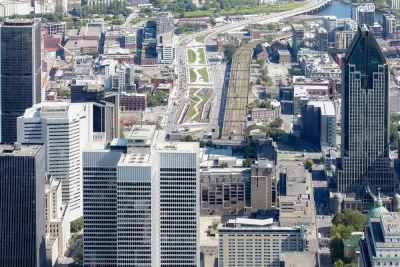More than one-half mile of elevated expressway was demolished in the heart of downtown Montréal to make way for a spectacular ground-level urban boulevard and over six acres of continuous public space, bookended by two monumental sculptures.

For more than 50 years, the elevated Bonaventure Expressway, built in 1966, cut across the city centre of Montréal, a thriving metropolis located on an archipelago in the middle of the majestic St. Lawrence River. This thoroughfare was a major gateway to the downtown core, accommodating more than 27,000 vehicles per day, including 1,900 buses. Rather than extending the service life of the aging structure, the city opted for a large-scale redevelopment, the first one of its kind in Canada, thereby making it possible to:
- Create an elegant, functional and people-oriented gateway to downtown Montréal
- Mesh together districts that were isolated by the elevated expressway
- Support private mixed-use development in the area
This bold initiative, spearheaded entirely by the City’s administration, forms the backbone of the Bonaventure Project which was completed on time and on budget (CAN$141.7 million).
In addition, Montréal was recently named Canada’s first recipient of a SITES certification, awarded by the Green Business Certification Inc. (GBCI) to honour the excellence demonstrated in implementing the innovative, sustainability-minded best practices that characterize the Bonaventure Project.
FULL STORY: Projet Bonaventure receives GBCI’s ‘SITES’ green building certification

Trump Administration Could Effectively End Housing Voucher Program
Federal officials are eyeing major cuts to the Section 8 program that helps millions of low-income households pay rent.

Planetizen Federal Action Tracker
A weekly monitor of how Trump’s orders and actions are impacting planners and planning in America.

Ken Jennings Launches Transit Web Series
The Jeopardy champ wants you to ride public transit.

Washington Legislature Passes Rent Increase Cap
A bill that caps rent increases at 7 percent plus inflation is headed to the governor’s desk.

From Planning to Action: How LA County Is Rethinking Climate Resilience
Chief Sustainability Officer Rita Kampalath outlines the County’s shift from planning to implementation in its climate resilience efforts, emphasizing cross-departmental coordination, updated recovery strategies, and the need for flexible funding.

New Mexico Aging Department Commits to Helping Seniors Age ‘In Place’ and ‘Autonomously’ in New Draft Plan
As New Mexico’s population of seniors continues to grow, the state’s aging department is proposing expanded initiatives to help seniors maintain their autonomy while also supporting family caregivers.
Urban Design for Planners 1: Software Tools
This six-course series explores essential urban design concepts using open source software and equips planners with the tools they need to participate fully in the urban design process.
Planning for Universal Design
Learn the tools for implementing Universal Design in planning regulations.
Heyer Gruel & Associates PA
Ada County Highway District
Institute for Housing and Urban Development Studies (IHS)
City of Grandview
Harvard GSD Executive Education
Toledo-Lucas County Plan Commissions
Salt Lake City
NYU Wagner Graduate School of Public Service


























